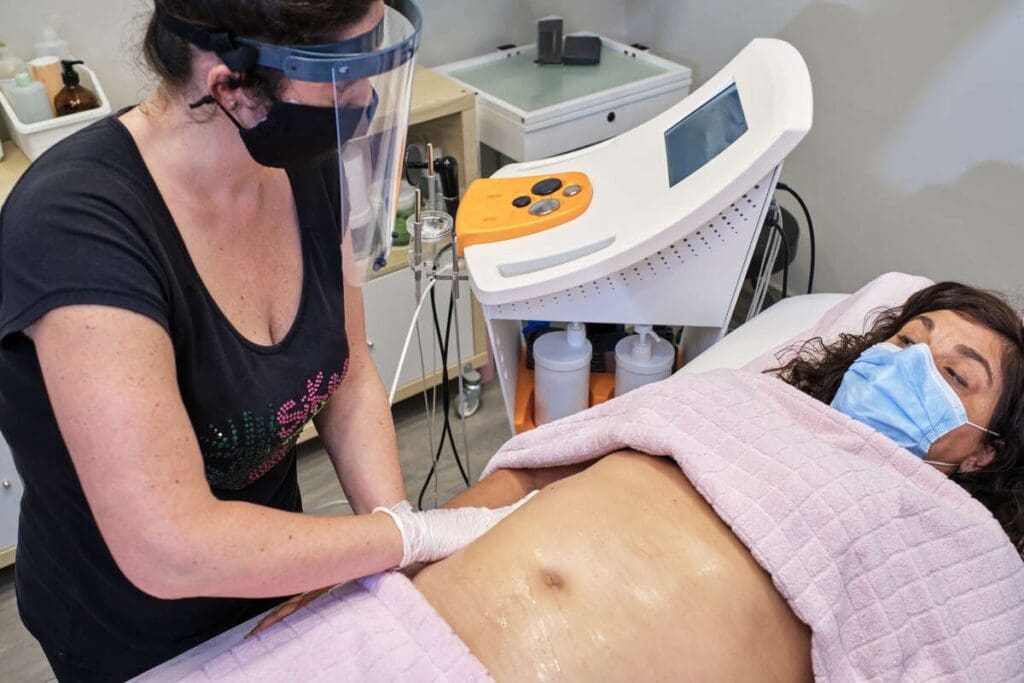Last Updated on November 25, 2025 by
A bladder ultrasound is a noninvasive imaging procedure. It’s used to check the bladder’s volume and wall thickness. Most patients find it painless, making it a good choice for many medical needs, especially in diagnosing conditions like interstitial cystitis.

Understanding the diagnostic process for interstitial cystitis is key for those with painful bladder syndrome. A bladder ultrasound is a big part of this process. It gives important information without causing pain.
This procedure is both comfortable and safe. It’s a vital tool in urology. It helps doctors accurately check bladder conditions.
A bladder ultrasound is a non-invasive test to check bladder health. It’s great for those with cystitis, frequent urination, and overactive bladder symptoms.
A bladder ultrasound uses sound waves to see the bladder. It helps doctors check the bladder’s shape and how it works. This tool spots problems that might cause symptoms.
To do a bladder ultrasound, a technician puts gel on your belly. Then, they use a transducer to send sound waves. These waves bounce off the bladder, showing images on a screen.

Bladder ultrasounds help find and track many conditions. These include interstitial cystitis, overactive bladder, and urinary retention. The tool gives clear images of the bladder.
This helps doctors create the right treatment plans for each patient.
A medical expert says, “Bladder ultrasounds have changed how we handle bladder problems. They’re non-invasive and very effective.”
“The use of bladder ultrasounds has greatly improved patient care. It lets us catch and treat bladder issues early.”
People with bladder problems often need tests like bladder ultrasounds. These tests help check the bladder and find out why it hurts. Knowing how much pain you might feel is important before the test.

Studies have found that bladder ultrasounds don’t hurt much. Most people say they feel almost no pain. This makes bladder ultrasounds a good choice for checking the bladder.
Bladder ultrasounds are way more comfortable than other tests like catheterization. Catheterization can hurt a lot and might cause infections. Ultrasounds don’t hurt as much and are safer.
Some people wonder if pee is sterile. Research says normal pee isn’t completely clean, but it’s mostly free of bacteria. Ultrasounds check the bladder without touching it, keeping it clean.
Most people say bladder ultrasounds don’t hurt much. They feel little to no pain. This is because the ultrasound doesn’t touch the bladder.
Even though ultrasounds are mostly painless, some things can make them feel worse. For example, if you have bladder spasms or a lot of bladder pain, you might feel a bit more discomfort. But doctors can help make you comfortable.
In short, bladder ultrasounds are mostly painless. Knowing what might make you feel more or less pain helps you get ready for the test.
Bladder ultrasounds have changed how we diagnose interstitial cystitis. This method is non-invasive and very accurate. It helps find this chronic condition, which causes bladder pain and pressure.
Ultrasounds are key in spotting symptoms of interstitial cystitis. They use sound waves to show the bladder’s details. Doctors can then diagnose the condition. Key symptoms include:
Measuring the bladder wall’s thickness is important in diagnosing interstitial cystitis. A thick wall often means chronic inflammation. Ultrasounds can measure this accurately. Studies have shown that people with interstitial cystitis have thicker walls than healthy individuals.
Ultrasounds are great for telling acute cystitis from interstitial cystitis. Acute cystitis is usually caused by a bacterial infection. But interstitial cystitis is a long-term condition without an infectious cause. Ultrasounds can spot the signs of interstitial cystitis, like a thickened wall and smaller bladder.
For those with painful bladder syndrome, ultrasounds are a non-invasive and pain-free way to diagnose. This is good because it avoids making the condition worse. The clear images help doctors make a treatment plan that works for each patient.
In summary, bladder ultrasounds are a key tool in diagnosing interstitial cystitis. They give detailed images and help spot symptoms. This makes it easier for doctors to diagnose and treat the condition.
To make your bladder ultrasound as comfortable as possible, consider these tips. A bladder ultrasound is a tool used to check the bladder and its area. Getting ready right can make you feel more at ease during the test.
Drinking water is key before a bladder ultrasound. It fills your bladder, making it easier to see during the test. Drink plenty of water as your doctor tells you, usually 32 ounces. But don’t drink too much, as it can be uncomfortable. A full bladder helps doctors see how it’s doing.
Wear comfy, loose clothes that let you move easily. Some places may give you a gown to wear. You’ll lie on your back during the test. The technician might put gel on your belly to help the ultrasound work better.
If you’re worried or anxious, talk to your doctor. They can help calm your fears. Talking openly is important for a good experience. This is true, even if you have special needs or worries.
Try deep breathing exercises or listen to soothing music to calm down. Some places offer relaxation methods or sedation. Being ready and informed can make you feel less anxious. This makes the test less stressful.
By following these tips, you can make your bladder ultrasound more comfortable. This makes the whole process easier and less scary.
Bladder ultrasounds are a key tool for diagnosing cystitis and bladder pain. This non-invasive method helps find bladder problems, like interstitial cystitis, without pain.
Studies and patient feedback show that bladder ultrasounds are very comfortable. They are a better choice than more invasive tests. Knowing what to expect can help patients feel less anxious and more at ease.
If you have bladder pain or cystitis symptoms, a bladder ultrasound is a good option. It’s a painless way to get a clear diagnosis. This helps doctors manage your bladder issues effectively.
No, a bladder ultrasound is usually painless. Most people feel little to no pain, with scores close to zero.
Interstitial cystitis is a long-term condition that causes bladder pain and frequent need to urinate. Ultrasounds of the bladder are key in diagnosing it. They measure the bladder wall’s thickness and look for symptoms.
Yes, a bladder ultrasound can tell the difference between acute cystitis and interstitial cystitis. It does this by checking the bladder wall’s thickness and other signs.
To feel more comfortable during a bladder ultrasound, drink plenty of water. Wear clothes that are easy to move in. Talk to your doctor about any worries you have. Use methods to calm your nerves.
Yes, conditions like cystitis, overactive bladder, and painful bladder syndrome might need a bladder ultrasound for diagnosis and check-up.
Urine is usually sterile. But, finding certain substances or bacteria in it can show bladder health problems, like infections or interstitial cystitis.
Yes, bladder spasms can be a sign of interstitial cystitis. A bladder ultrasound can help find out if you have this condition.
During a bladder ultrasound, the bladder is filled to check its size and wall thickness. This helps diagnose different bladder problems.
Subscribe to our e-newsletter to stay informed about the latest innovations in the world of health and exclusive offers!